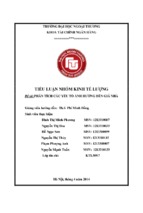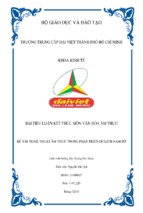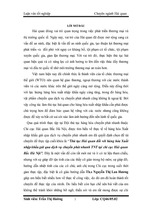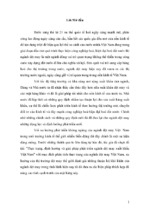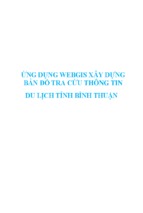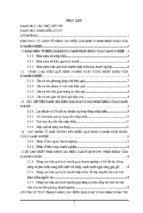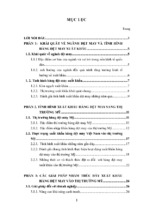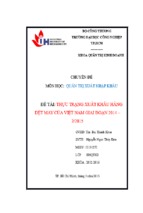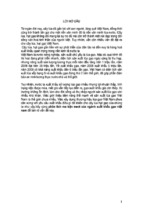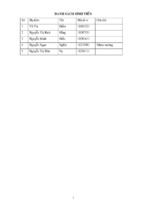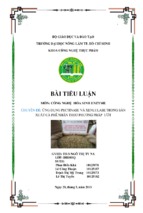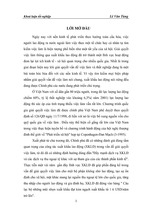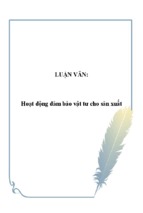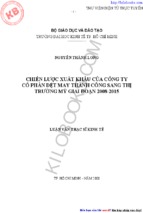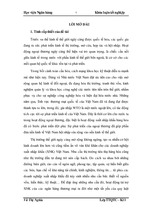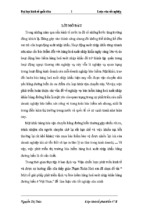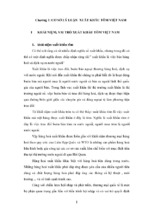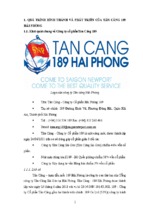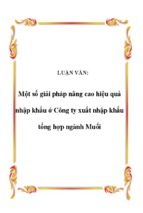ii
Acknowledge
I would like to express my appreciation for my tutor – Dr. Nguyen Duc Tri for his
valuable comment and assistance.
I also want to thank Ms. Camilla Berglund and Mr. Phan Le Dung for their
supporting to finish this project.
Yours sincerely,
iv
CONTENT
EXECUTIVE SUMMARY ............................................................................................... 1
CHAPTER 1: INTRODUCTION
1.1 Project Objective and Significance ...................................................................... 3
1.2 Methodology……………………………………………………………………... 3
1.3 Project Limitation................................................................................................ 4
1.4 Company Overview............................................................................................. ..
1.4.1 Background.................................................................................................. .4
1.4.2 Mission ......................................................................................................... 4
1.4.3 Value of FV ................................................................................................. .5
CHAPTER 2: LITERATURE REVIEW
2.1 Medical Tourism………………………… ………………………………………...
2.1.1 Definition …………………………………………………..…………………6
2.1.2 Brief History of Medical Tourism ..………………………..…………………7
2.1.3 Different between Health and Medical Tourism …………..…………………7
2.1.4 Key Players in Medical Tourism Industry ….……………..…………………9
2.2 Contributing Factors in becoming Medical Tourism Destination ...………………...
2.2.1 Pull and Push Factor …………...…………………………………..…..……10
2.2.2 Motivation Factors in Medical Tourism .…………………..………………..10
CHAPTER 3: SITUATION ANALYSIS.............................................................................
3.1 SWOT Analysis ................................................................................................ 12
3.2 Competitor Forces.................................................................................................
3.2.1 Vietnam.................................................................................................... 13
3.2.2 Asia .......................................................................................................... 13
3.3 Key to success.......................................................................................... 14
3.4 Technology in Medical Tourism ....................................................................... 14
3.5 Target Market........................................................................................................
3.5.1 Medical Tourism of U.S Market ............................................................... 15
3.5.2 Other influencing factors .......................................................................... 16
3.5.3 U.S Plastic Surgery................................................................................... 19
3.5.4 Market Trend............................................................................................ 19
3.6 Survey............................................................................................................... 20
CHAPTER 4: MARKETING STRATEGY ........................................................................
4.1 Segmentation .................................................................................................... 23
4.2 Target Segment ................................................................................................. 23
4.3 Positioning ........................................................................................................ 23
4.4 Marketing Mix .....................................................................................................
v
4.5
4.6
4.4.1 Product ..................................................................................................... 23
4.4.2 Price ......................................................................................................... 25
4.4.3 Distribution .............................................................................................. 26
4.4.4 Promotion................................................................................................. 27
Marketing Budget.............................................................................................. 29
Conclusion ........................................................................................................ 29
REFERENCES …………………………………………………………………….30
APPENDICES ………………………………………………….………………….32
1
EXECUTIVE SUMMARY
There are many tourism typologies: sport, leisure, religion, pilgrim pursuit, historical
discovery and others. The trend in combination of tourism and medical is called medical
tourism which tourists primarily seek medical treatment and afterwards the more beneficial
experience related to leisure and relaxation in tourist places.
Today culture of travelling abroad for surgery becomes more common in the world,
especially people from developed countries fly to Asia to absorb cosmetic surgery regard
to price connotation. There are optimistic forecasts about medical tourism development in
the future. According Deloitte Medical Tourism Update, 540,000 American traveled
abroad to receive medical treatment in 2008 and estimated 1.62 million medical tourists in
2012. The expected increase in medical tourism derives from high cost of healthcare in
their home country, better customer care, the ease and affordability of international travel
and improvements in both technology and standards of care in many countries.
Medical Tourism has contributed remarkable to GDP of many countries such as Singapore,
Thailand and India. It brings benefits not only for hospital as increasing revenue,
innovating infrastructure but also for its country economy as creating jobs for local people,
improving life conditions… With those benefits, medical tourism plays important role for
bringing more money to national budget. Recognizing these potential interests, Thailand
governments have pushed promotion for the development of medical tourism by reducing
barriers to attract more patients to their countries. As a result, the number of international
patient increases quickly. Besides Thailand, India, Singapore and Malaysia also put efforts
to lure the flow of oversea patient deciding their surgery procedures done in their
countries.
Vietnam doesn’t promote to this model currently. Medical Tourism is quite new to
Vietnam. However, as a trend of development, it’s believed that Vietnam will be soon a
tough competitor for neighbor countries in future.
2
FV is the first hospital to take part in this model in Vietnam. FV Hospital has operated
since 2003. Its facilities were noticeably invested for years with foreign and Vietnamese
doctor team who are trained oversea in reputation hospital in France.
In order to increase the operational efficiency, FV wants to attract medical tourism patients
who want to combine their traveling to Vietnam with having medical treatment such as
health check up, hip replacement, dental treatment or plastic surgery. Therefore, this
project will help FV to become a competitive medical provider in medical tourism market
3
CHAPTER 1: INTRODUCTION
1.1 Project Objective and Significance
The main purpose of this project is to increase operational efficiency of FV Hospital by
building an effective marketing plan to attract abroad patients to FV Hospital. It could be
done by analyzing external and internal factors to implement the right method in foreign
countries.
It is recognized that there is an expansion in demand of Plastic surgery in U.S. According
to Deloitte Consulting, over hundred thousand of Americans travel abroad for medical
treatment in 2008. This number will increase by million in 2015. That’s a huge potential
market for FV.
This project is designed to understanding the effective factors and competitive advantages
to attract medical tourists to FV hospital. Besides, it helps FV to become a global medical
hub. The significance of this project has indicated that:
+ Accelerating hospital revenue by attracting more foreigners who can combine cosmetic
surgery with holiday trip.
+ Analyzing clearly proper factors the marketing mix for attracting medical tourism have
created more successful opportunity and reduced risks.
1.2 Methodology
Descriptive method is used to identify and obtain information on Plastic Surgery in the
target market.
1.2.1 Desk Research (Secondary data)
The research use data from different resources published on economic newspapers,
magazines, internet… for collecting information about plastic surgery industry in U.S,
Social and psychology of American for Plastic Surgery and new trend for this industry in
future.
1.2.2 Market Research (Primary data)
Qualitative survey is done by focus group with American visitors in Vietnam
4
Quantitative survey is taken by survey with 80 American in U.S by email.
1.3 Project Limitation
This project outlines a marketing plan which will be applied for US market only. Other
international market could have some similar points but not completely included.
Plastic surgery is the only surgery package in Medical Tourism mentioned in this
project.
Due to geographic conditions, the survey in this project is only done with 50
interviewees by email.
1.4 Company Overview
1.4.1 Background
FV Hospital is a world class healthcare in Vietnam offering a comprehensive care range of
medical and surgical services. It is a wholly foreign-owned hospital, opening in March
2003 and equipping with modern machine to provide patients with efficient treatments. It
teams composed of Vietnamese who are oversea trained), French, Belgian, American and
Korean doctors.
FV Clinic is a branch of FV hospital located in district 1 giving more convenient options
for patients who live in center. FV operating revenue is more than 18 million USD in 2009
serving over 200,000 patients a year including 70% Vietnamese, 20% Western and Asian
expatriates, 5% Cambodia and 5% Viet Kieu and tourists.
It is also the first hospital in Vietnam to be accredited by an international organization
HAS and working to achieve “Joint Commission International” by 2010.
1.4.2 Mission
FV is an international organization in Vietnam for over 7 years. It becomes a trustful brand
in Vietnam community with different society contributed activities such as charity trip to
poor village in Vietnam for free consultation and medicine delivery.
It mission: “FV provide superior quality and comprehensive patient care in a continuous
effort to gain patient trust”
5
1.4.3 Value of FV
FV is non-stopping providing high quality service to serve patient in the best condition and
make them comfortable. It believes in “Medical Ethics”. Value of FV includes:
Being patient centered
Being Professional, caring, trustworthy, compassionate and responsible.
Empathy with patients, share their thought and understand how their feeling.
Striving to provide comprehensive and high quality care including good doctors and
nurses, high quality facilities, customer services teams…
6
CHAPTER 2: LITERATURE REVIEW
The aim of this chapter is to provide relevant literature about medical tourism. It includes
definition of Medical Tourism, history of Medical Tourism. It also discusses about
motivation factors in Medical Tourism.
2.1 Medical Tourism
2.1.1 Definition
Medical tourism refers to patients that are traveling overseas for affordable treatment.
Cabllero-Denell and Mugomba (2007) defines medical tourism as the pursuit of medical
care abroad and simultaneously engage in more conventional form of tourism.
Connell (2005) defines medical tourism as a niche industry “where people often travel long
distances to oversea countries to obtain medical, dental and surgical care while
simultaneously being holiday makers, in a more conventional sense”.
According to Daub’s study (as cited in Newman, 2006), medical tourism is the attempt by
many Americans to save money by traveling to other countries for their medical needs.
This focuses on the Americans while others define differently.
Keckly and Underwood (2008) noted that medical tourism is the process of “leaving
home” for treatments and care abroad or elsewhere domestically. It is an emerging
phenomenon in the healthcare industry.
In addition, according to Horowitz and Rosensweig (2007), “medical tourists” seek
modern healthcare at affordable prices in countries variable levels of development.
In short, medical tourism is the attempt by patients to seek for a qualified and high quality
medical healthcare at foreign countries at an affordable price or cheaper price. It does not
limit to traveling to modern countries to seek for better service but most important is the
affordable price with the same quality of service. This combination of surgery and tourism
is a new niche tourism that expects significant growth in next years.
7
2.1.2 Brief History of Medical Tourism
Base on website www.health-tourism.com, Medical Tourism has developed since ancient
times. Most ancient civilizations recognized the therapeutic effects of mineral thermal
springs and sacred temple baths. As a result, these places become a fashionable destination
for rich people flocking to recover and health retreat. The “Spa” first used in Renaissance
Period of the 14th to 17th century was attached with wellness resorts.
The forms of medical tourism evolve variously. In the 1990s to 1997, the USA and Europe
were not only the commercial and industrial centers, but they were also the center of the
healthcare world. Medical travel was limited to the rich people who traveled to these
countries to receive high-end medical services. However, the cost of healthcare rising in
the 1980s and 1990s, American patients started considering offshore options, like dental
services in Central America.
Due to the Asian economic crisis in 1997 and the collapse of Asian currencies, Asia
countries decided to push medical tourism marketing their countries as premier
destinations for international healthcare. Thailand quickly became the salient destination
with competitive price compare to Western countries.
It was in 1997 that the Joint Commission International was formed to check and investigate
international healthcare facilities for conformance to international standards due to the
emergence of health providers around the world
In Vietnam, medical tourism is quite new market for Vietnam. In November 2006, the first
medical treatment as acupuncture was launched in tourism market by professor Nguyen
Tai Thu. In addition to, many wellness resort and spa was growing in last few years.
However, providing more depth medical treatment with international standard such as
dental treatment or plastic surgery is not popular in Vietnam.
2.1.3 Different Between Health and Medical Tourism
8
According to Benett et al (2004) defines health tourism as follow “Health tourism would
be any pleasure orientated tourism which involves an element of stress relief” means it is
an enjoyable and relaxing activity.
William (2000) expands the definition as combination of health and tourism in leisure,
recreational and educational activities which focus on the improvement of physical, mental
and social well being.
Health tourism is a very broad category that encompasses a wide variety of treatments and
services whist medical tourism becomes a subset of health tourism. Henderson (2004)
views health tourism as travel where the primary purpose is treatment in pursuit of better
health and medical tourism incorporates health screening, hospitalization and surgical
operations. In the study of Mugomba and Caballero Danell (2006), they have developed
the health tourism structure.
The Health Tourism Structure
Health Care Tourism
Wellness Tourism
Medical Tourism
Non Cosmetic Surgery
or Elective Surgery
Cosmetic Surgery
Wellness tourism inclines for people seeking a form of relaxation or stress relief at a spa or
yoga retreats while a medical tourist has two components – the medical procedure and the
leisure element.
Similarly, Connel (2006) identify health tourism with general health and wellbeing, while
medical tourism combines tourism with medical surgical or dental intervention to improve
9
or restore health in the long term. Therefore health and medical tourism are differentiated
by the level of surgical and physical intervention on the tourist’s body.
Although health and medical tourism could be separated on the consequent level of
physical and surgical intervention required, there are still controversial about this.
2.1.4 Key Players in Medical Tourism Industry
Medical tourism operators can be divided into two groups. First, there are medical centers
such as hospitals or clinics. Medical centers actively attract international patient to obtain
their medical procedures but in many case, also responsible for all patient logistic from
arrival to departure
The second group is medical tourism facilitators or referrers who function like agents and
associated service provide. They are often smaller companies with just a few people
dealing with hospitals and clinics in different countries. These facilitators offer for
international patient option accessing international healthcare with competitive price
compare to his or her home country.
These facilitators provide necessity information and assist patients with pre and post- travel
medical issues. They also provide resources for follow up care upon the patient’s return.
Medical tourism package often includes cost of medical care, transportation, travel
arrangements, hotel accommodation during the post recovery period. Hospitals being either
JCI or ISO accredited or affiliated with recognized medical institutes such as Harvard and
Johns Hopkins are priority opted as partners of medical tourism facilitators.
2.2 Contributing Factors In Becoming Medical Tourism Destination
Motivations play a significant role in choosing medical destination. Understanding these
factors would help to attract customer effectively. It can be classified into two forces to
describe how individual is motivated in opting medical tourism place for their treatments.
2.2.1 Pull and Push Factor
Push factor is classified among motivational factors and conceptualized as the motives and
needs that influence his decision to take a vacation. Push factor can be defined as factor
10
that motivate or create a desire to travel. It originates from intrinsic desires of human being
including desire for escape, dream fulfillment, rest, relaxation…
Pull factors consist of both tangible and intangible elements such as the features,
attractions or attributes of the destination itself. The pull factors include social
opportunities and attractions, natural and culture, foods, infrastructure, recreation activities.
2.2.2 Motivation Factors in Medical Tourism
A published article on www.hospitalimpact.org by Ph.D Maria K.Todd states when
employers and their employees are pushed to the wall financially for the cost of health
benefits which is increasing with time, employers has started to think about health services
migration encouraging their staffs across border for medical care.
Also according to Todd, push factors include the cost and access to care challenges, more
people used to traveling for work, more students and recent graduates who spent time
abroad in different cultures and employers who are beginning to test the waters, especially
if health plan is a self-funded trust rather than a fully insured plan, high levels of
technology and high quality of care and a general perception that it’s possible to maintain
more privacy abroad. Otherwise, pull factors compose of rapid access to affordable care
and more expatriates working further away who cannot come back home for care.
In addition to, improvements in transportation infrastructure encourage health services
migration. Also developments in telemedicine for monitored care, physician to physician
communication with pre-operative and post-discharge follow up are reasons for medical
tourism or health services migration more practical.
In the context of medical tourism, push factors explain the reasons and desires to travel for
health services and pull factors determine the destination of choice. Based on source
United Nation (2007) push factors comprise of
Non-coverage of certain procedures by insurance companies
Accelerating the cost of medical insurance leads to an increasing number of people
who are underinsured or underinsured
11
Increasing popularity of cosmetic surgery in developed countries
Waiting lines for surgical procedures in developed countries
While pull factors include in
Languages
Culture and social environment
Geopolitical Events
Tourist Attraction
High quality healthcare
Affordable and Cost Saving Alternatives
Value Add On and Personalized service
Development of communication and transportation
12
CHAPTER 3: SITUATION ANALYSIS
3.1 SWOT Analysis
The aim of SWOT analysis captures the key internal and external factors of FV Hospital,
and also describes the opportunity and threat.
* Strength
* Weakness
- Five-star service hospital including - New Brand in Medical Tourism market
experience doctor and modern facilities
- The number of room is limited (only 200
- Accredited by international organization rooms in total)
including
HAS-French
Accreditation, - Small budget for marketing
JCI– U.S Accreditation
- Not experience on Medical Tourism
- Personalized service is offered for market
medical tourism patient to assist them - Not experience on medical tourism
during their stay in Vietnam.
market
- Competitive price due to lower labor - High rotate foreign doctors.
costs.
- Political Stability
- Travel benefits
* Opportunity
* Threat
- More demand of cosmetic surgery
- High competition
- The number of arrival tourist to Vietnam - Competitors have better technique and
increases over years
experiences in treatment
In SWOT analysis, FV do have some strong points to compete with its rivals. In present
situation, political stability of a country is carefully considered as choosing medical
tourism destination. Besides competitive price to obtain five star services in world class
hospital, personalized service and travel benefits are our solid advantages. Even we have
some weak points, there are chances to succeed. Moreover, opportunity and threat analysis
13
also offer a positive outward looking for FV including the increase of demand and the
development of technology.
3.2 Competition Forces
3.2.1 Vietnam
In Ho Chi Minh, at least 200 plastic surgery clinics are in operation in Vietnam but none of
them is the real competitor of FV Hospital. Most are operated by individual and not
followed international quality such as hygiene, no guarantee for surgery they provide or
even don’t well-equipped to handle with any occurring emergency case happing during
surgery.
According to thesaigontimes launched on 13 August 2009, Vietnam does still not have any
hospital achieved International Accreditation JCI – Joint Commission International which
is one of pull factors to attract Medical Tourism patient to Vietnam’s hospitals.
3.2.2 Asia
Innovative healthcare system and advance in technology have supported medical tourism
among the Western countries for many years. According to a report of United Nation
(2007), Malaysia, Singapore, India, Thailand attracted over 1.4 million medical travelers
and earned over US 1 billion in treatment costs alone. In 2005, the number of international
traveler will surpass 2.5 million.
In website www.hotelmarketing.com, Thailand wants to attract two million foreign
patients by 2010 up to 1.5 million in 2005 while Philippines hopes for 700,000 patients up
to 250,000 in 2006. India’s medical tourism business is growing at 30 per cent per year
and is forecast to generate at least US$2.2 billion a year by 2012. Singapore is targeting to
attract one million foreign patients annually and push the GDP contribution from this
sector above US$1.6 billion, while Malaysia expects medical tourism receipts to be in the
region of US$590 million in five years’ time.
14
Country
Arriving from
India
Middle East, United US 48 million (2005)
Cardiac
Kingdom,
joint replacements,
Malaysia
Estimated earnings
Canada,
Strengths
surgery,
developing countries
eye surgery.
Indonesia,
Cardiology, cardio-
United US 40 million (2004)
States, Japan
thoracic
surgery,
cosmetic surgery.
Singapore
Thailand
Malaysia, Indonesia, US 560 million (2004)
Liver
Middle East, United
joint
States
cardiac surgery
United States, United US 1 billion (2006)
Cosmetic
Kingdom,
organ
transplants,
dental
treatment,
Middle
East, China, Japan
transplant,
replacement,
surgery,
joint replacements.
Source: UN, 2007
3.3 Key to success
For FV hospital, these are key elements to success
World class hospital: experience doctors and modern facility, especially hygiene
condition.
Personalized service: assisting during treatment in Vietnam, outstanding customer
service
Travel benefits: many beautiful sightseeing and landscapes meeting different
recreational purpose including leisure, culture or historical experience.
3.4 Technology in Medical Tourism
Technology plays a vital role to medical tourism. It helps bridge the geographical gap such
as seeking information efficiently, communicating easily in pre and op- operative phase.
An emergence of technological development has contributed to simplify the medical
traveler process.
15
First, in Medical tourism, this technology is mentioned as telehealth or telemedicine which
is the remote provision of health care services enabled by technology. According to
Medical Tourism Association, this telehealth includes range from the transmission of
digital photographs and patient histories for diagnostic consultation, to remote monitoring
of physiologic data for chronic disease management, to interactive patient physical
examination using medical video endoscopes and ultrasound over high-definition
videoconfereing links.
In Medical Tourism Magazine, telehealth is classified into two primary operational
modes: 1. real-time or synchrononous and 2. deferred or asynchronous. They improve
quality, efficiency and customer service in medical tourism applications by better
coordination of care between patients and medical providers, optimizing patient and family
member travel.
Technology also subsidizes to medical tourism through proliferation of air transportation
facilitating patients easily to reach to provider’s country. Internet, in particular social
network contributes to search information in making decision.
3.5 Target Market
3.5.1 Medical Tourism (outsourcing) of U. market
Although America is a developed country with advanced technology and method in
medical treatment, it’s too expensive for noninsured or underinsured American. According
to business-in-asia.com and www.health-tourism.com, there are reasons for them to be
medical tourists.
Price
Lower price is the main advantage of medical tourism. U.S health care costs are often
higher than the combined fee of traveling and receiving medical abroad.
High quality healthcare abroad
There are many new and renovated private hospitals that use cutting edge technology and
equipment. The doctors in these facilities are trained to American and European standards,
providing service that is equal or greater to what hospitals in USA offer.
Service
16
Most of medical tourists are escorted and cared during their visit trip. Moreover, if staying
overnight in the hospital, patients only have to pay cheap price compare to room facility.
No wait-list
Patient can access to immediate service. In many countries, people have to wait for months
or years to receive medical treatment.
Lack of Insurance
The Miami Herald, November 2, 2008 revealed that while the USA continues to debate
over their medical insurance system, 61 million people are either uninsured or underinsured. In addition to, Cosmetic and Dental surgeries are not covered at all by insurance.
Tourism
Patients having minor procedures can enjoy their recovery by staying in a relaxing
vacation environment in beautiful surroundings. Patient accompanied by others can enjoy
some quality time, relaxing on the beach or going shopping to relieve much of stress.
Receiving treatment anonymously
American patients who are traveling abroad for medical treatment can receive their
treatments in privacy and recover in comfort without questions and judgment from people
who know them.
3.5.2 Other influencing factors
3.5.2.1 U.S Economy
Economic contributed on demand of medical tourism. As the economic recession, a shift in
the demand for certain types of medical procedures. Many patients who are seeking
elective surgeries such as plastic or cosmetic procedures wait and spend the money after
they see how the economic recession will affect their personal lives. However, other
procedures such as orthopaedic, cardiac and transplants have accelerated due to cost
saving.
Base on www.businessandmedia.org, the prolonged U.S recession has had a significant
impact on patient’s ability to afford medical care. Increasing unemployment has likely
contributed to the growing number of uninsured in the U.S. Since insurance coverage for
medical treatment is not widely covered, it is an option for American traveling to receive
17
elective procedures, not acute illness that requires immediate attention. As a result, demand
of outbound medical travelers is fueled.
3.5.2.2 U.S Demography
According to CIA World Fact Book, the estimated number of U.S population in July 2010
is 310,232,863. Age from 15-64 occupied the highest number in age structure.
Sex
Age
Percentage of population
Male
Female
0-14
31,639,127
30,305,704
20.2%
15-64
102,665,043
103,129,321
67%
65 and over 65
16,901,232
22,571,696
12.8%
3.5.2.3 U.S Healthcare Reform
Healthcare reform in the United States has been enacted via two bills: the Patient
Protection and Affordable Care Act which became law on March 23 2010 and was shortly
thereafter amended by the Health Care and Education Reconciliation Act of 2010 which
became law on March 30. The new law mandates that by 2014, people must have adequate
insurance coverage or else pay a fine. It is estimated will reduce the number of the
uninsured from 19% of all residents in 2010 to 8% by 2016.
There is no restriction for U.S citizens traveling outside the countries to obtain the medical
procedure. In addition to, US Healthcare Reform has a positive impact on outbound
Medical Tourism from the United States. With the passage of healthcare reform, the
treatment cost is more expensive. Therefore, medical tourist is an attractive election to
many U.S citizens.
Healthcare Reform will significantly increase the cost of health insurance in the US and the
kinds of non-covered benefits for many Americans, encouraging more US insurance
- Xem thêm -


